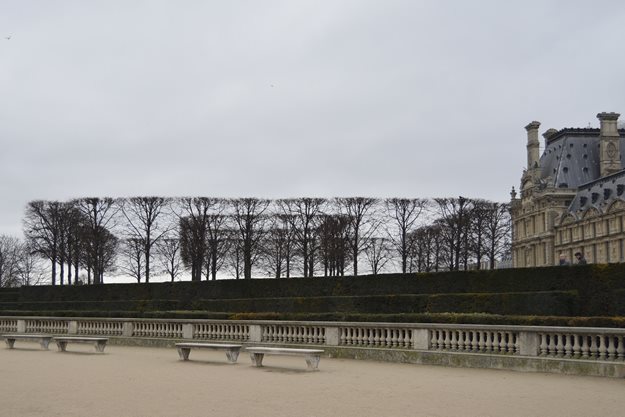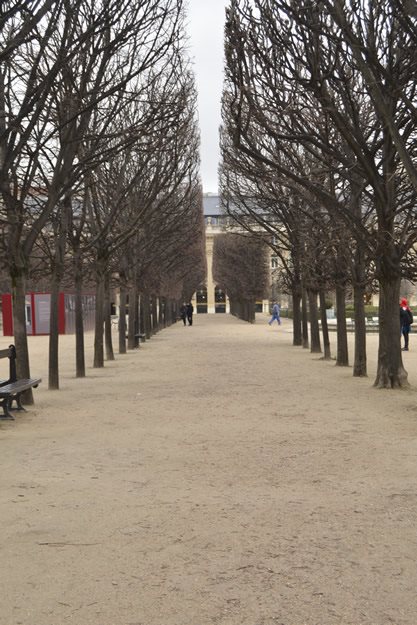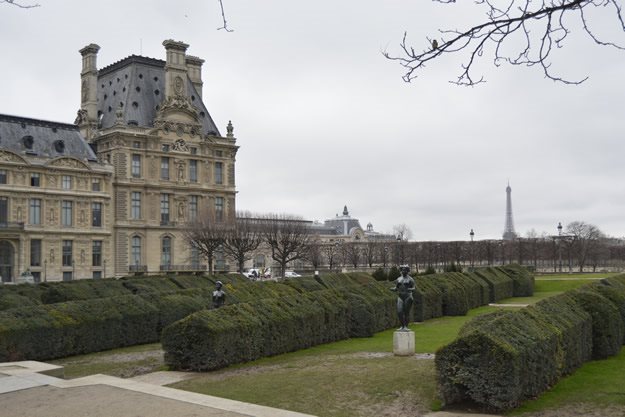Paris Parks: A Celebration of Winter Structure

The ethereal structure of these trees in the Tuileries in Paris will be obscured in spring when they leaf out. The height of trees in the Tuileries is controlled to maintain vistas and views. Photo: Susan Cohan
SEE MORE PHOTOS OF THIS GARDEN.
For more than 400 years, the French have been enjoying formal gardens and parks that are the antithesis of today’s current trend towards naturalistic ‘prairie’ style planting. In the summer, these gardens may lack the lush, colorful qualities of herbaceous driven garden design, but in winter, when their structure takes its starring role, they are sculptural, ethereal and beautiful. They are celebrations of a manmade style of garden that doesn’t pretend to be anything but just that. There is no attempt at recreating or mimicking nature in these outdoor spaces.
These formal spaces have clean lines and thoughtfully arranged elements that give them a timeless quality. Evergreen hedging and geometric planting schemes define areas and direct views. Hedging can be elaborate or simple. Careful, skilled maintenance and patience is required to create and care for these gardens which explain one reason why they’ve fallen out of favor with so many. It takes a very long view and highly skilled pruning for a garden like this to reach maturity. There are those who believe that this type of gardening is unsustainable, yet they’ve thrived and are have been used daily for more centuries. Perennial and grass based gardens can look good in a season or two and suit our short attention spans. There are fewer opportunities in this type of garden to change course or fix a mistake. Their relative simplicity shows every detail, good and bad.

In the Jardin du Palais Royal just behind the Louvre, trees create shaded promenades with slivers of views above and beyond. Photo: Susan Cohan
SEE MORE PHOTOS OF THIS GARDEN.
Pleached and pollarded trees fill the vertical and overhead planes. For those who view this artificial practice as unnecessary and outmoded, there are positive reasons to pollard. Pollarded trees live longer than those that remain unpruned. It can multiply the range of niches that increase value to wildlife for both feeding and nesting. Places with high concentrations of old pollards have been found to have the highest levels of biodiversity in Europe. In the parks in Paris, trees are protected and given every opportunity to thrive. Topiaried shrubs, trees and other major plants have their roots protected by simple yet effective barriers. Trunks are wrapped and gently staked to protect from winter winds and drying. Older trees are crutched and supported to extend their lives whenever possible. Hand pruning is practiced and parks have visible compost areas-something that would be hidden in American parks.
Public gardens and parks in Paris aren’t static historic sites. In 2004, Belgian landscape designer, Jacques Wirtz completed a large hedged addition to the Tuileries which have been developed for centuries. Even, Andre le Notre, whose 400th birthday is this year, added his ideas to what was then an extension of the king’s garden. He extended the Tuilerie’s westward vista into what would become today’s Champs Élyssées.

Jacques Wirtz installation of architecturally pruned hedging at the Tuileries in Paris. Photo: Susan Cohan
SEE MORE PHOTOS OF THIS GARDEN.
Like any other garden, these parks are living, breathing, and highly used outdoor places that are, like any other added to and subtracted from. Used as parks, they are still called gardens, because that’s what they were originally. Each one has wide walks and narrow side trails, gathering places, playgrounds, pleasure gardens with fountains and sculpture of all varieties. There are new and old plantings, containers and annual displays. There are places to sit in the shade or bask in the sun. There are places for intimate conversation and open space for sports. Above all these are places for people to enjoy themselves and admire something beautiful every day on a grand and clearly manmade scale.
